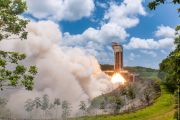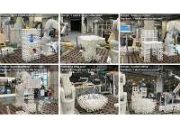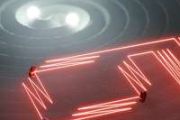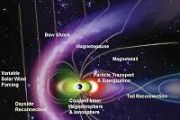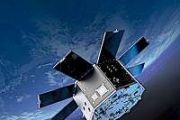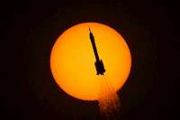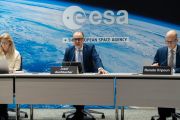
Copernical Team
NOAA adopts Finland’s CubeSat-proven space weather monitor

An advanced X-ray monitoring instrument tested for space aboard an ESA CubeSat will serve as an operational space weather payload on the US National Oceanic and Atmospheric Administration's Space Weather Next Lagrange 1 Series satellite, currently planned for launch in 2028, which will operate 1.5 million km from Earth, keeping watch for eruptions from our Sun.
Einstein Industries Ventures joins ESA Investor Network

ESA’s Investor Network continues to grow, with Einstein Industries Ventures as its latest member via the signature of a collaboration agreement.
Over the next ten years, Einstein Industries Ventures’ management team targets a fund worth €300 million to invest in Europe's leading growth-stage New Space downstream technologies, Earth observation and sensor technology.
Space exploration goes underground
 Is there life in Martian caves? It's a good question, but it's not the right question-yet. An international collaboration of scientists led by NAU researcher Jut Wynne has dozens of questions we need asked and answered. Once we figure out how to study caves on the Moon, Mars and other planetary bodies, then we can return to that question.
Wynne, an assistant research professor of cave ecol
Is there life in Martian caves? It's a good question, but it's not the right question-yet. An international collaboration of scientists led by NAU researcher Jut Wynne has dozens of questions we need asked and answered. Once we figure out how to study caves on the Moon, Mars and other planetary bodies, then we can return to that question.
Wynne, an assistant research professor of cave ecol Try, Try Again: Sols 3655-3656
 Yesterday we weren't able to use the arm and thus weren't able to do contact science, but a short drive got us into a better position. Unfortunately, the dust removal tool still wasn't safe to use at our location, so the team decided to make another drive to try again for contact science on the weekend. Even though the plan wasn't what we expected coming in to today, we were still able to make t
Yesterday we weren't able to use the arm and thus weren't able to do contact science, but a short drive got us into a better position. Unfortunately, the dust removal tool still wasn't safe to use at our location, so the team decided to make another drive to try again for contact science on the weekend. Even though the plan wasn't what we expected coming in to today, we were still able to make t Rocket Factory Augsburg to use test infrastructure at DLR Lampoldshausen
 Space start-ups with micro-launcher projects will be important players in European space transport in the future. So-called micro-launchers are smaller rockets that can carry payloads of up to one tonne into low Earth orbit. They complement the capabilities of the established Ariane European launcher and will accelerate the development of new business areas and technologies in the launcher marke
Space start-ups with micro-launcher projects will be important players in European space transport in the future. So-called micro-launchers are smaller rockets that can carry payloads of up to one tonne into low Earth orbit. They complement the capabilities of the established Ariane European launcher and will accelerate the development of new business areas and technologies in the launcher marke LunIR joins CAPSTONE as 2nd Terran built Lunar satellite to launch this year
 Terran Orbital Corporation (NYSE: LLAP), a global leader in satellite-based solutions primarily serving the aerospace and defense industries, has announced the successful launch of LunIR. The Moon-mapping satellite is the second Terran Orbital-developed lunar satellite to launch this year - the first being CAPSTONE. Launched on June 28, CAPSTONE became the first satellite to enter a Near-Rectili
Terran Orbital Corporation (NYSE: LLAP), a global leader in satellite-based solutions primarily serving the aerospace and defense industries, has announced the successful launch of LunIR. The Moon-mapping satellite is the second Terran Orbital-developed lunar satellite to launch this year - the first being CAPSTONE. Launched on June 28, CAPSTONE became the first satellite to enter a Near-Rectili Galactic Energy carries out fourth successful launch
 Galactic Energy, a private carrier rocket maker in Beijing, carried out the fourth flight mission of its CERES 1 rocket on Wednesday afternoon to deploy five Earth-observation satellites into orbit.
The CERES 1 Y4 rocket blasted off at 2:20 pm at Jiuquan Satellite Launch Center in northwestern China's Gobi Desert and soon placed the Gaofen 03D08, 03D51, 03D52, 03D53 and 03D54, five optical
Galactic Energy, a private carrier rocket maker in Beijing, carried out the fourth flight mission of its CERES 1 rocket on Wednesday afternoon to deploy five Earth-observation satellites into orbit.
The CERES 1 Y4 rocket blasted off at 2:20 pm at Jiuquan Satellite Launch Center in northwestern China's Gobi Desert and soon placed the Gaofen 03D08, 03D51, 03D52, 03D53 and 03D54, five optical NASA's Artemis I cameras to offer new views of Orion, Earth, Moon
 During Artemis I, NASA's Space Launch System (SLS) rocket will send the agency's Orion spacecraft on a trek 40,000 miles beyond the Moon before returning to Earth. To capture the journey, the rocket and spacecraft are equipped with cameras that will collect valuable engineering data and share a unique perspective of humanity's return to the Moon.
There are 24 cameras on the rocket and spac
During Artemis I, NASA's Space Launch System (SLS) rocket will send the agency's Orion spacecraft on a trek 40,000 miles beyond the Moon before returning to Earth. To capture the journey, the rocket and spacecraft are equipped with cameras that will collect valuable engineering data and share a unique perspective of humanity's return to the Moon.
There are 24 cameras on the rocket and spac Shenzhou XIV taikonauts perform third spacewalk
 The Shenzhou XIV crew on board the orbiting Chinese Tiangong space station is conducting their extravehicular activities for the third time, according to the China Manned Space Agency.
Commander Chen Dong has already gotten out of the space station, and crew member Cai Xuzhe will subsequently exit. Taikonaut Liu Yang is inside the core module to support her crewmates, the agency said in a
The Shenzhou XIV crew on board the orbiting Chinese Tiangong space station is conducting their extravehicular activities for the third time, according to the China Manned Space Agency.
Commander Chen Dong has already gotten out of the space station, and crew member Cai Xuzhe will subsequently exit. Taikonaut Liu Yang is inside the core module to support her crewmates, the agency said in a Looking to Artemis I for a return to the moon
 On Nov. 16, NASA successfully launched the Artemis I mission after several launch delays. Artemis I is an uncrewed test flight featuring a Space Launch System (SLS) rocket that will send the Orion spacecraft around the moon and back to test the system and hardware extensively before future flights with astronauts.
The first of several missions, Artemis I will pave the way for subsequent mi
On Nov. 16, NASA successfully launched the Artemis I mission after several launch delays. Artemis I is an uncrewed test flight featuring a Space Launch System (SLS) rocket that will send the Orion spacecraft around the moon and back to test the system and hardware extensively before future flights with astronauts.
The first of several missions, Artemis I will pave the way for subsequent mi 














